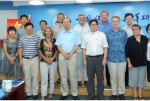This August, six scientists from the Moorea Coral Reef (MCR) and Santa Barbara Coastal (SBC) LTER sites were hosted for two weeks by their colleagues in the People's Republic of China to discuss potential areas for cooperation with marine ILTER sites in the Chinese Ecosystem Research Network (CERN).
Despite their rich history of interaction, marine sites in LTER and CERN have yet to forge linkages. However, a visit to SBC in October 2009 by scientists and officials from the Chinese Academy of Sciences (CAS), National Science Foundation of China (NSFC) and the US National Science Foundation (NSF) highlighted the potential opportunities for cooperation between the US and Chinese long term research networks, especially on the effects of global climate change on marine ecosystems.
Funding by NSF's Office of International Science and Engineering and generous logistical support from the Chinese hosts enabled Russ Schmitt, Dan Reed, Sally Holbrook, Bob Carpenter, Ruth Gates, and Pete Edmunds to hold a series of planning meetings throughout China. The meetings culminated in a workshop with CAS scientists and graduate students at the Sanya Tropical Marine Biology Research Station on Hainan Island. The main goals of the trip were to assess opportunities for cooperation for the marine LTER community in general, and to explore how to expand the vibrant program of exchange and research collaboration between MCR and the Kenting Coral Reef site in Taiwan to include CERN's Sanya Coral Reef site. CERN consists of 55 sites, of which four focus on coastal marine ecosystems.
The US delegation first met with officials at CAS headquarters in Beijing to gain deeper insight into potential areas of cooperation, and the most effective ways to build them. The LTER scientists then visited the CAS Institute of Oceanology at Qingdao (which boasts 500 Ph.D. researchers), where they learned about the research themes and findings of the Jiaozhou Bay CERN program; toured the Institute's impressive facilities; participated in a formal planning meeting; and made a field trip with scientists and graduate students aboard a small oceanographic vessel to the Jiaozhou Bay site.
The LTER delegation then traveled to the Sanya Tropical Marine Biology Laboratory where they met with scientists and students working on the Sanya Coral Reef site, toured the lab and field site, and participated in a two-day science workshop that highlighted research themes and projects of mutual interest between the two networks. After the workshop, the delegation traveled to Guangzhou to meet with scientists at the CAS South China Sea Institute of Oceanology (which has 400 Ph.D. researchers), which administers the Sanya lab.
The LTER team found great interest at all levels within CERN in developing research collaborations and student exchanges with marine sites in the LTER Network. Their Chinese counterparts expressed interest in participating in more focused workshops with LTER marine scientists to identify specific research themes and potential collaborative projects -- an objective that is now being pursued.
With respect to student exchanges, NSF's existing East Asia and Pacific Summer Institute (EASPI) program could be used to fund LTER graduate students to work with CAS researchers and their CERN sites.
Moorea and Santa Barbara LTER scientists tour Chinese marine ILTER sites
By:
Sally Holbrook (MCR) By:
Russ Schmitt (MCR) 
 Enlarge this image
Enlarge this image

